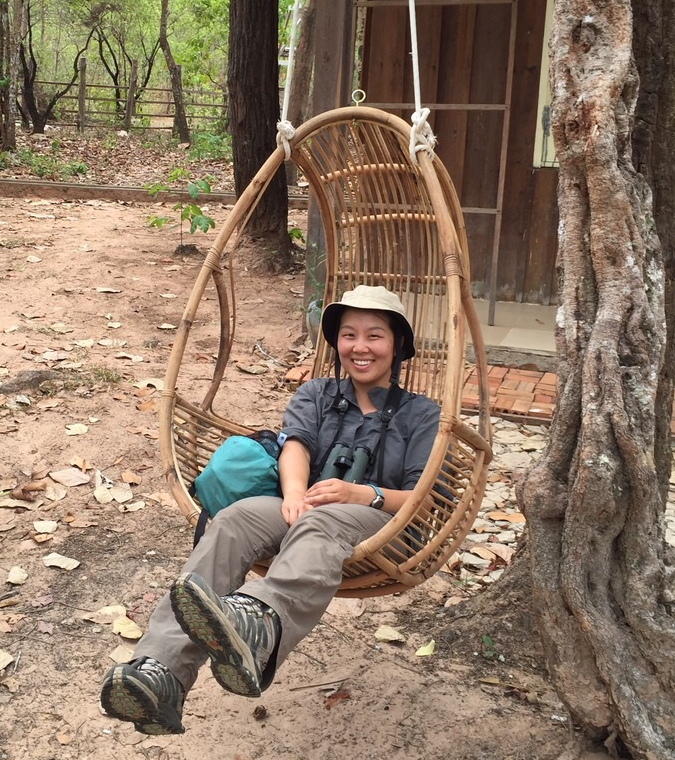NIMBioS Postdoctoral Fellow Charlotte Chang
Q&A with Dr. Chang
Hometown: Santa Barbara
Field of Study: Ecology, Conservation, Quantitative Biology
What is your field and why does it inspire you? Why did you choose this field?
My hometown of Santa Barbara has a unique landscape where the Santa Ynez mountains lie to the north and the Pacific Ocean to the south. The mornings are overcast, the air slightly saline, and the aerial acrobatics of songbirds dot the sky. As a child, I tested different birdseed combinations on handmade peanut-butter feeders. The feeders inevitably crumbled within a week, but my curiosity about my flying neighbors became a deep and abiding love of birds and nature.
It wasn't, however, until my first undergraduate ecology course where I sat, binoculars in hand, watching birds forage in dense patches of sagebrush, that I began to study birds in a more rigorous way. I became drawn to mathematical ecology, to its clear, precise explanations for complex phenomenon. After working in the field, I realized that the natural world—in all its variety, harshness and beauty—was my preferred laboratory.
After university, I had the privilege to work as a Fulbright Fellow in China. Working with scientists and conservationists taught me how my work could motivate policies to conserve wildlife. My experiences in Asia underscored that the pressing needs of 7.1 billion people necessitate agile and flexible conservation tools in addition to traditional habitat and species protection.
Describe your current research.
My research focuses on human interactions with the environment, looking into feedback loops between natural resources and their uses. Two major forms of human-environment interactions are hunting and land management under agriculture. I have used mathematics to describe how hunting in the tropics proceeds from a human perspective as well as its impacts on wildlife populations. I have also developed statistical tools to assist managers in measuring the rates of conservation crimes such as illegal blast fishing or entry into protected areas. In tropical countries, agroforestry—tree plantation crops such as rubber or coffee—have a large spatial footprint. I have examined how and when agroforests in China and India can augment existing protected areas for habitat specialist birds.
What is the primary aim of your research? What is your primary professional goal?
I seek to identify ways where human aspirations can be reconciled with the needs of wildlife. I also aim to advance statistical tools and conceptual theories for wildlife managers and researchers, particularly in tropical regions, which often have unique limitations in terms of finances and personnel.
What is the biggest obstacle to achieving your objective(s)?
Limited data and monitoring capacity severely hampers conservation planning in the tropics. Although robust information on the status and distributions of wildlife populations, human-wildlife interactions, and plant-animal interactions has remained elusive, there is a suite of exciting developments in the fields of conservation and ecology and beyond. Citizen science has greatly enhanced the scope of data collection, particularly for birds, and reporting tools have allowed indigenous communities to partner with protected area management bureaus.
How does your work benefit society?
In rural regions in the developing world, hunting wildlife is important for protein access for the most food insecure and can provide a source of income. Sustainably managing this resource for long-term human welfare and biodiversity conservation has been challenging, and in many locations, the quantity of wildlife harvest vastly exceeds safe thresholds. My work provides mechanistic theories of hunter behavior in complex environments where many species are targeted simultaneously, which will clarify how management should set goals and enact monitoring. Additionally, I have developed tools to improve conservation oversight.
What do you like best about your work?
Through my research, I have been able to work with so many unique and incredible individuals. My field assistants in China, all of whom are seasoned hunters and naturalists, have really amazing life experiences and an unmatched appreciation for the local environment. It has been an honor to become part of the family. None of my work would have been possible without the generous collaborative spirits of my Chinese and Indian counterparts, and it has been inspiring to work with and learn from students, managers, and research scientists in these countries.
What would your Tweet say about your work?
I explore human-wildlife interactions such as hunting and agroforestry management using statistical tools and mathematical theory.
What is the most surprising aspect of your work?
Hunters (in China) just want to have fun. It has long been posited that hunting in developing world, tropical regions is primarily driven by a desire to put food on the table or get money in one's pocket. What I found in the course of my work is that although the villagers of Southwest China historically hunted for subsistence, their motives for going into the field had become more intangible: a sense of camaraderie, the thrill of the chase, and an escape from the ordinary.
What exciting developments lie in the future for your field?
Bioacoustics is a really promising area of research, and alongside proven techniques such as camera trapping, should greatly enhance "real-time" field observations of mammal and bird populations. Greater integration of the social sciences into ecology and conservation is another area of active and exciting collaborative research.
What do you do when you're not in the lab or out in the field?
I am a runner-birder-eater and occasional (very occasional) baker. I really enjoy all of the in-depth and thoughtful articles that Kenji Lopez-Alt writes on Serious Eats (The Food Lab). During my time in Knoxville, I am really excited to check out musical shows and delicious dining. I've already had a great time at Sweet P's and Bida Saigon. Running at Ijams (especially Tharp's Trace) has been humbling, and I am delighted to be challenged by Knoxville's varied and beautiful terrain.
Charlotte Chang's Postdoc page
NIMBioS
1122 Volunteer Blvd., Suite 106
University of Tennessee
Knoxville,
TN 37996-3410
PH: (865) 974-9334
FAX: (865) 974-9461
Contact NIMBioS



